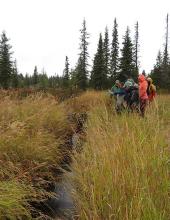
As communities in Alaska ’s Kenai Lowlands prepare for a changing climate, information about groundwater is essential to manage the watershed for both people and salmon.
To better understand the availability of groundwater and how human activities impact this resource, a collaborative research project led by the Kachemak Bay National Estuarine Research Reserve and University of South Florida built a model that shows the depth and extent of aquifers and predicts groundwater discharge and recharge. The project team joined this new science with local expertise to interpret the groundwater model for use in land use planning, permitting, policy decisions, and habitat protection. The project developed a suite of tools and trainings to help stakeholders better understand groundwater dynamics.
About this resource
As part of this project, Kachemak Bay National Estuarine Research Reserve and their collaborators led site visits for community members and stakeholders. Participants learned from experts on watershed and estuarine ecological systems and gained a greater understanding of local and regional conservation science and watershed resilience strategies.
A process agenda and site profile were created for the Stariski Creek Meadows field visit on July 25, 2019. These resources provide an example for others interested in developing field based learning or stakeholder engagement processes.
- Process agenda - Outlines site visit objectives, field-based learning activities, and key takeaways.
- Site profile - Describes the location's physical characteristics, land ownership, logistics, and key topic areas for field-based learning.